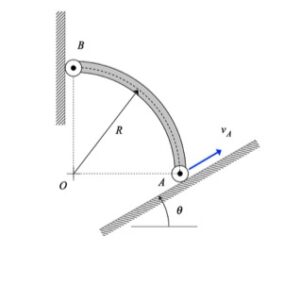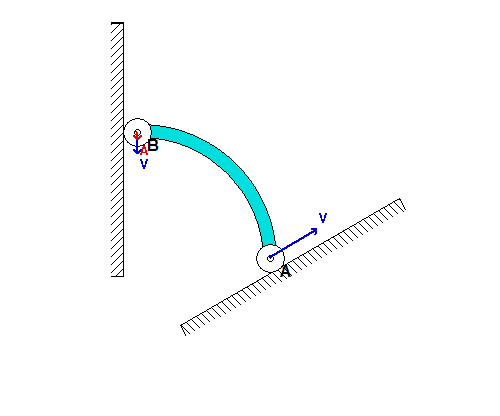| Problem statement Solution video |
DISCUSSION THREAD

Discussion and hints:
The solution for the velocity and acceleration of end B is a straight-forward application of the rigid body velocity and acceleration equations for member AB:
vB = vA + omega x rB/A
aB = aA + α x rB/A - ω2*rB/A
where vB = vB*j, vA = vA*(cos(θ)*i + sin(θ)*j), aB = aB*j and aA = aA*(cos(θ)*i + sin(θ)*j). Each of the two vector equations above represents two scalar equations, providing us with the necessary equations to solve for vB, ω, aB and α.
HINT: The solution for this problem follows very closely that of Example 2.A.7 of the lecture book. If you get stuck on this problem, it is recommended that you review the solution video for Example 2.A.7 on the course website.

For the inclination angle used in the above simulation, we see that point B moves DOWNWARD along the vertical wall as A moves up along the incline. As B moves onto the same horizontal plane as A, the acceleration of B becomes very large (although A continues to move with a constant speed). Can you provide a physical explanation for this?

If we now consider a steeper inclination angle for A, as used above, we see that end B initially moves UPWARD along the wall; however, at some point B reverses its direction and begins to move DOWNWARD along the wall. Can you provide a physical explanation for this? Note also that the acceleration of B becomes very large as B moves onto the same horizontal plane as A, as it was for the initial value of inclination angle.
What is the value of the incline angle theta that defines the boundary between the types of initial motions for bar AB shown in the above two simulations? For the numerical value of the angle theta provided in the problem statement, which of the two simulations above agree with your results?
Any questions?? Please ask/answer questions regarding this homework problem through the "Leave a Comment" link above.
So, wait - I'm trying to figure out how the acceleration of point A is 0, and I'm a little confused about how this thing is moving. Is it naturally falling and letting gravity pull it down? Is force being applied on point A to keep it moving at a constant speed? Or is none of the above happening?
BRANT:
Yes, in order for A to moving at a constant speed, there would be a force acting on A to keep it moving at a constant speed.
Please keep in mind that we are currently studying KINEMATICS, the study of the motion of a system (velocities and accelerations).. At this point we are NOT dealing with the forces that need to be applied to produce the motion of interest. That will come later in the course, in Chapter 5.
Okay, so I tried to use the vec_vB = vec_vA + vec_omega x vec_rB/A formula (shown above). I got vec_vA = vA(cos(theta)i + sin(theta)j) and omega x vec_rB/A = -omegaRi - omegaRj, and when I solved for i = 0, I got vec_vB = vA(sin(theta)-cos(theta))j, which made sense.
However, when I substituted theta, I got a positive answer, which didn't make any sense; the vector is clearly pointing downward at the start. Where did I go wrong?
I got the same answer that you got for velocity. I initially thought that it should be negative, but the description of the problem shows a scenario where B initially moves up but has a negative acceleration.
There seems to be a discrepancy between the pdf and what is listed here. It says in the pdf that A is moving with a constant velocity, but here on the blog it is written that aA = aA*(cos(θ)*i + sin(θ)*j). Can we use what is on the pdf or should we change it?
FELIX:
Each time that we use one of the homework problems, we typically change numerical values for the given parameters. The blog discussion above is intended to be for the general problem, regardless of the given value for the acceleration of A.
This semester (as you note above) it is given that A is moving with a constant speed. So, follow the hints above using a_A = 0. The next time that the problem is assigned, we might give a_A a non-zero value.
Make sense?
When creating the equation for Vb should I make the vector Vb -> -Vbj or Vbj. If I put a negative the answer is positive and vise versa. The final answer should be negative since it is moving in the negative j direction I feel.
Although based on the image provided on the pdf it does appear that B would move in the negative j direction, if you consider the Theta provided, the picture does not exactly match the scenario described numerically. Based off of the animations included with the problem, I believe there is initially movement in the + j direction.
Either approach is fine. Just keep in mind that the sign on your answer for v_Bj will depend on the sign that you initially chosen.
When answering part b of this problem do we need to serve an explanation as to why we have choosen the answer we got?
I would just in case. I just wrote out a sentence on the relationship between B's velocity and acceleration vectors and how its velocity vector would be changed due to the acceleration vector.